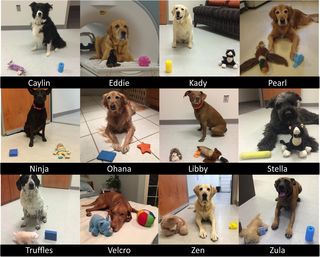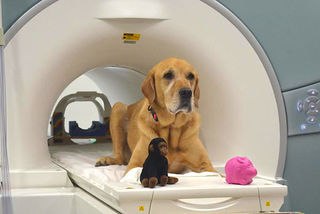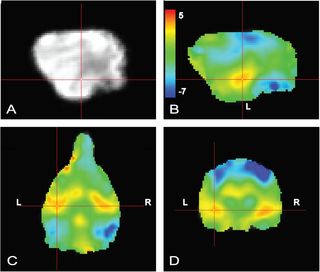Neuroscience
Awake fMRI Reveals How Canine Brains Process Novel Words
Neuroimaging shows dogs differentially process pseudowords and trained words.
Posted October 17, 2018
"We wanted to get data from the dogs themselves — not just owner reports."
Emory University's Dr. Gregory Berns and his colleagues have been studying various aspects of dog behavior using awake-fMRI analyses for a number of years. Dr. Berns founded The Dog Project was the first to train dogs to enter a functional magnetic resonance imaging (fMRI) scanner voluntarily and to remain still during scanning without restraining or sedating them. More than 880 dogs have been trained to date.
I've posted a number of essays about their groundbreaking work (please see for example, "How Dogs View the World: Brain Scans Tell Us What They See," "Jealousy in Dogs: Brain Imaging Shows They're Similar to Us," and "Dogs Are People, Too: They Love Us and Miss Us fMRIs Say") as well as an interview with Dr. Berns about his book called What It's Like to Be a Dog: And Other Adventures in Animal Neuroscience. In this interview he notes, "The overarching theme is that we see startling similarities in how animals’ brains function. This means that all animals — whether dog or human — have many neural processes in common. So when we see the same part of a dog’s brain active as a human’s under similar conditions, the implication is that the dog is experiencing something very similar to us. Just like humans, we see tremendous variation in these responses from one dog to another. This means that dogs, like humans, are individuals. We are quickly moving beyond the question of 'what it’s like to be a dog' to 'what it’s like to be that dog'.” In Canine Confidential: Why Dogs Do What They Do I've stressed that there is no being who we can reliably call "the dog" because of the enormous amount of variability among these amazing animals, even right after birth. Sure, there are some general trends, but what always catches my eye is the enormous amount of within-species variability among dogs, including littermates, siblings, and other members of the same breed or mix.
Berns and his colleague's seminal work continues and they have recently published an essay in Frontiers of Neuroscience called "Awake fMRI Reveals Brain Regions for Novel Word Detection in Dogs" that is available online for free. An accurate summary of this research can be found in a piece titled "Scientists chase mystery of how dogs process words." The rationale for this study is as follows: “Many dog owners think that their dogs know what some words mean, but there really isn’t much scientific evidence to support that,” says Ashley Prichard, a Ph.D. candidate in Emory’s Department of Psychology and first author of the study. 'We wanted to get data from the dogs themselves — not just owner reports.'” Dr. Berns notes, “We know that dogs have the capacity to process at least some aspects of human language since they can learn to follow verbal commands...Previous research, however, suggests dogs may rely on many other cues to follow a verbal command, such as gaze, gestures and even emotional expressions from their owners.”

To conduct their research into the way dogs' brains process words, 12 dogs of different breeds volunteered by their human were trained to retrieve two objects -- one soft and another of different texture -- by name. During training, the owners were asked if their dog showed a preference for one object over the other. The majority preferred to softer object and this was labeled as word1 and object1. Zola did not complete the project because she wasn't able to complete the MRI scan. Details about the methods there were used can be found in the research essay.

After training, dogs' brains were then scanned in the MRI machine as they were exposed to two trained words and the corresponding objects. (The full caption for the photo of Eddie reads, "Eddie, one of the dogs that participated in the study, poses in the fMRI scanner with two of the toys used in the experiments, 'Monkey' and 'Piggy.'") Pseudowords were used as a control and were followed by the presentation of novel objects. They included "a bubble wand, Barbie doll, stuffed caterpillar, wooden train whistle, plastic gumball dispenser, yellow hat, watermelon seat cushion, Nerf ball launcher, etc."

The researchers discovered that the dogs clearly heard the words and saw the objects when in the MRI scanner. They write, "positive activation was localized to the auditory cortex for words and negative activation for presentation objects in parietal cortex (Figure 4; image to the left), confirming that the dogs heard the words and saw the objects." Using whole-brain analyses, they also discovered "Whole brain analysis of the contrasts of interest revealed significant activation only within the right parietotemporal cortex for the contrast [pseudowords – trained words]" and "Whole brain analysis of the contrasts of [word1 – word2] and [novel – unexpected] were not significant as no cluster survived thresholding at the voxel significance mentioned above."
Additionally, they used searchlight multivoxel pattern analysis (MVPA) to explore potential brain regions that may code for different representations of the words. They write, "The searchlight map of word1 vs. word2, which identified regions involved in the discrimination of the trained words, showed four clusters of informative voxels (Figure 6): posterior thalamus/brainstem; amygdala; left temporoparietal junction (TPJ); and left dorsal caudate nucleus. Seven dogs shared informative voxels in or near the left temporal cortex that passed the 0.63 accuracy threshold (Figure 7)." They also learned that seven dogs "displayed clusters in the left temporal and parietal lobes, suggesting some heterogeneity in the location underlying word discrimination." When they compared their data to what is known for humans, they write "The manner in which dogs learn words is different than humans do...Although humans readily generalize the meaning of words to a variety of contexts, this may not be the case for dogs."
What dogs' ears tell dogs' brains: What do words mean to them?
"...dogs’ processing of human words utilizes basic processes like novelty detection, and for some dogs, may also include auditory and hedonic representations."
The results of this seminal study can be summarized as follows. I quote some from the original research paper to be sure to get things right. The researchers write, "Using awake-fMRI in dogs, we found neural evidence for auditory novelty detection in the domain of human speech. The hallmark of this finding was greater activation in parietotemporal cortex to novel pseudowords relative to trained words. Thus, even in the absence of a behavioral response, we demonstrate that dogs process human speech at least to the extent of differentiating words they have heard before from those they have not. The mechanism of such novelty detection may be rooted in either the relatively less frequent presentation of the pseudowords (oddball detection) or the lack of meaning associated with them (lexical processing)." (My emphasis)
The authors also ask, "So what do words mean to dogs?" Their answer: "Even though our findings suggest a prominent role for novelty in dogs’ processing of human words, this leaves the question of what the words represent. One possibility is that the words had no further representation other than the relative hedonic value of the objects." Their final conclusion reads, "These results highlight potential mechanisms by which dogs process words. Word novelty appears to play an important role. The strong response of the parietotemporal region to pseudowords suggests that dogs have some basic ability to differentiate words with associations from those that do not. Future studies may reveal whether these representations remain in the auditory domain or whether such representations are invariant to modality." When comparing their results to humans, researcher Ashley Prichard notes "people typically show greater neural activation for known words than novel words."
So what does this all mean?
Clearly, dogs' brains detect different words, with novelty being an important variable in how and where this is done. When the results are considered as a whole, Dr. Berns says the present study shows dogs "appear to have a neural representation for the meaning of words they have been taught, beyond just a low-level Pavlovian response.” The researchers also are careful to note that the results may have been influenced by the breeds and mixes of the dogs they studied, their different sizes, and variations in individual cognitive abilities. They also stress that their conclusions do not mean "spoken words are the most effective way for an owner to communicate with a dog. In fact, other research also led by Prichard and Berns and recently published in Scientific Reports, showed that the neural reward system of dogs is more attuned to visual and to scent cues than to verbal ones." Along these lines, Ashley Prichard notes, “From the dog’s perspective, however, a visual command might be more effective, helping the dog learn the trick faster.”
I really enjoyed reading about this research and learning about how dogs' brains process different words. It's clearly ecologically relevant research in that it truly taps into a very common way, perhaps the most common way, in which humans and dogs communicate with one another. Research such as this also demonstrates that canine science is not a "soft science," and that detailed neurobiological and ethological studies are crucial to learning more about how dogs interact in and sense their world.
Stay tuned for more on the fascinating cognitive and emotional lives of dogs. There still is so much to learn.




